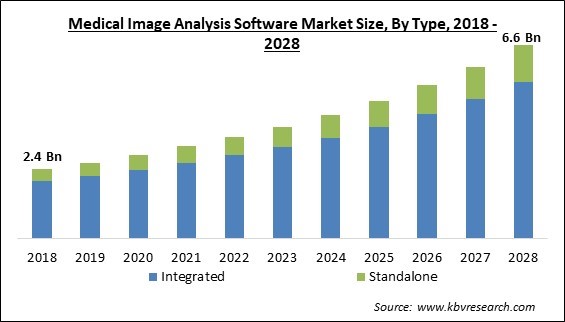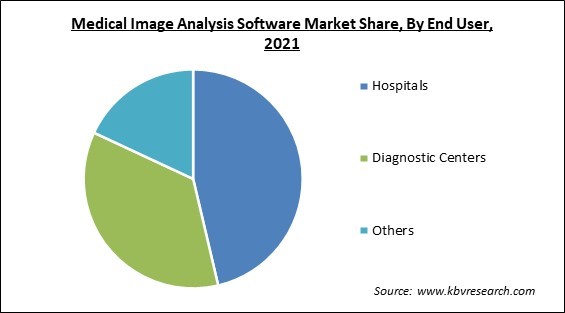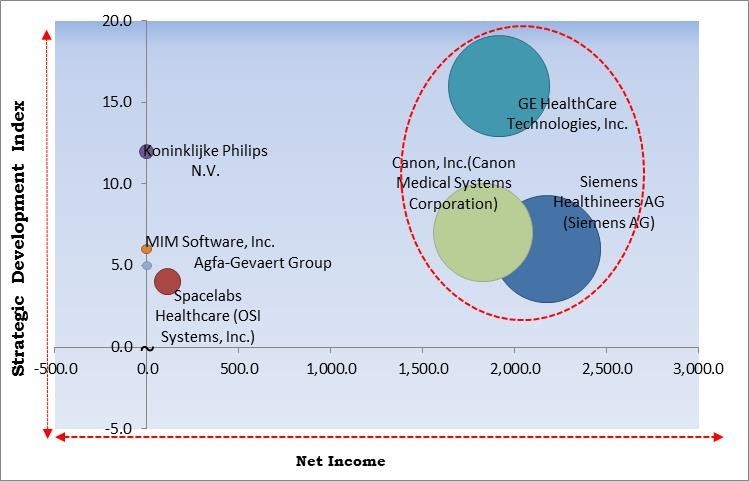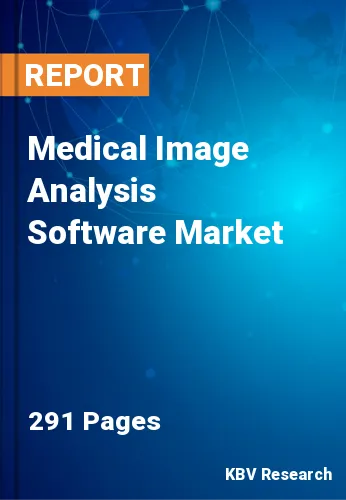The Global Medical Image Analysis Software Market size is expected to reach $6.6 billion by 2028, rising at a market growth of 11.4% CAGR during the forecast period.
Medical personnel can track, archive, organize, and manipulate patient images using medical image analysis software. In addition, diagnostic equipment must have medical image analysis software since it enhances the qualities of an image, improving the effectiveness or efficiency of medical therapy. The purpose of this software is to save, view, train, and share medical data.

Growing demand for diagnostic imaging software in disciplines, including dental, orthopedics, neurology, urology, and oncology, is projected to expand the market. Furthermore, the need is anticipated to increase as ultrasonic imaging devices are used more frequently for quicker diagnosis, particularly chronic disorders. Additionally, it is projected that ongoing advancements in imaging technologies, like computer-aided diagnosis (CAD), would increase demand for these systems.
Furthermore, medical image analysis software market dynamics have evolved in recent years as a result of the advent of artificial intelligence (AI), and this is expected to continue in the near future. Applications for AI-based solutions in medical imaging include image analysis, clinical decision support, diagnosis, and detection. Although the use of AI in MRI and CT technologies is still in its infancy, it is projected that demand for efficiency, accuracy and patient safety will grow throughout the forecast period.
Growing consumer demand is fueled by the adoption of technologically advanced goods such as multimodality imaging platforms and 3D imaging, as well as the advantages of using these systems, like high-resolution imaging, easy use, and flexibility. In the upcoming years, the market expansion is anticipated to be fueled by the release of technologically sophisticated products and the development of effective information management systems.
The market was positively impacted by the rise in demand for medical image analysis software used in clinical or medical applications to analyze chest scan pictures and diagnose COVID-19-infected patients. Also, there was a huge surge in the usage of telehealth globally. Patients might communicate with medical professionals remotely and share their medical records, including X-ray, magnetic resonance imaging (MRI), ultrasound, and other imaging modalities' images. These elements supported the expansion of the market for medical image analysis software.
Medical imaging has proven to be an indispensable diagnostic and monitoring tool for serious diseases and disorders. Artificial intelligence (AI) improves picture processing and analysis in medical imaging. AI-enabled medical image analysis software utilizes enormous quantities of medical data to train its algorithms to recognize certain anatomical markers in medical pictures acquired from X-rays, magnetic resonance imaging (MRI), ultrasound imaging, and other modalities. Using image algorithms and a rigorous study of medical picture patterns, AI-enabled software for medical image analysis derives metrics and outputs.
ML will enable radiologists to discover and interpret results, control quality, and potentially automate findings, interpretations, and dosage estimation in radiological imaging by automating the correlation and integration of pictures with other data. Using data-driven decisions, point-of-care medical imaging also supports radiologists, emergency personnel, doctors, and patients in hastening diagnosis and treatment. These innovative technological advancements are anticipated to support the growth of the medical image analysis software market in the upcoming years.
In the medical image analysis software market, hacking is a significant issue because hackers can readily manipulate system equipment, leading to data breaches or affecting patient outcomes. In addition, the growing reliance on software exacerbates problems such as bugs, malfunctions, and cyber vulnerability. Due to the detrimental effects of inadvertent malfunction and hacking, healthcare practitioners are cautious about using IT solutions, like image analysis software, in medical procedures. Loss of effectiveness & adverse consequences on patients may come from tampering with medical equipment. This may be an obstacle to the expansion of the market in the years to come.
Based on type, the medical image analysis software market is segmented into integrated and standalone. In 2021, the integrated segment held the highest revenue share in the medical image analysis software market. This large proportion is attributed to the advantages of using these solutions. A variety of radiology applications can benefit from the integrated toolkit's improved workflow. Increased acceptance of integrated systems because of their advantages-affordability, centralized data storage, and access to real-time data for various users to process-is projected to further expand the segment's revenue share.

On the basis of modality, the medical image analysis software market is fragmented into computed tomography, magnetic resonance imaging, ultrasound, combined modalities and others. In 2021, the ultrasound segment recorded a remarkable revenue share in the medical image analysis software market. Ultrasound is among the primary techniques used for imaging organs and soft tissues. Ultrasonic imaging is a non-invasive, radiation-free imaging technology. Moreover, it offers imaging in real-time. Ultrasound is a low-cost procedure when compared to other medical imaging methods. The domains of medical image analysis and computer-assisted interventions are concerned with reducing digital picture volume.
By application, the medical image analysis software market is divided into orthopedic, dental, neurology, cardiology, oncology and others. In 2021, the neurology segment projected a prominent revenue share in the medical imaging market. This is due to the rising prevalence of brain cancer, tumors, and other brain-related disorders, leading to the increased usage of CT and MRI, pushing the market for software over the forecast period. In addition, the increased emphasis on the most recent technological breakthroughs in the medical industry has a substantial impact on the expansion of the market.
Based on end user, the medical image analysis software market is bifurcated into hospitals, diagnostic centers and others. In 2021, the hospital segment registered the maximum revenue share in the medical image analysis software market. Supportive infrastructure, which is essential for performing surgical procedures with medical imaging software, is one of the most important aspects contributing to the segment's growth. The installed base of diagnostic imaging equipment and solutions is greater in hospitals compared to research and diagnostic facilities. In addition, the influx of patients is significantly greater. Hence, the end-use market continues to maintain its advantage.
| Report Attribute | Details |
|---|---|
| Market size value in 2021 | USD 3.1 Billion |
| Market size forecast in 2028 | USD 6.6 Billion |
| Base Year | 2021 |
| Historical Period | 2018 to 2020 |
| Forecast Period | 2022 to 2028 |
| Revenue Growth Rate | CAGR of 11.4% from 2022 to 2028 |
| Number of Pages | 291 |
| Number of Table | 484 |
| Report coverage | Market Trends, Revenue Estimation and Forecast, Segmentation Analysis, Regional and Country Breakdown, Competitive Landscape, Companies Strategic Developments, Company Profiling |
| Segments covered | Type, Modality, End User, Application, Region |
| Country scope | US, Canada, Mexico, Germany, UK, France, Russia, Spain, Italy, China, Japan, India, South Korea, Singapore, Malaysia, Brazil, Argentina, UAE, Saudi Arabia, South Africa, Nigeria |
| Growth Drivers |
|
| Restraints |
|
Region wise, the medical image analysis software market is analyzed across North America, Europe, Asia Pacific and LAMEA. In 2021, the North America region led the medical image analysis software market by generating the highest revenue share. Its rise is attributable to the availability of well-established medical facilities with sophisticated diagnostic equipment and favorable government measures that encourage the deployment of healthcare information technology in this region. In addition, increasing R&D expenditures and the presence of important market participants also contribute to expanding the regional market.
Free Valuable Insights: Global Medical Image Analysis Software Market size to reach USD 6.6 Billion by 2028

The major strategies followed by the market participants are Partnerships. Based on the Analysis presented in the Cardinal matrix; GE HealthCare Technologies, Inc., Siemens Healthineers AG (Siemens AG), Canon, Inc.(Canon Medical Systems Corporation) are the forerunners in the Medical Image Analysis Software Market. Companies such as Koninklijke Philips N.V., MIM Software, Inc. and Spacelabs Healthcare (OSI Systems, Inc.) are some of the key innovators in Medical Image Analysis Software Market.
The market research report covers the analysis of key stake holders of the market. Key companies profiled in the report include Canon, Inc. (Canon Medical Systems Corporation), Koninklijke Philips N.V., GE HealthCare Technologies, Inc., Siemens Healthineers AG (Siemens AG), Spacelabs Healthcare (OSI Systems, Inc.), Agfa-Gevaert Group, MIM Software, Inc., Esaote SpA, Aquilab SAS (Coexya), and Merative L.P. (Francisco Partner)
By Type
By Modality
By End User
By Application
By Geography
The global Medical Image Analysis Software Market size is expected to reach $6.6 billion by 2028.
Technological enhances in medical imaging systems are driving the market in coming years, however, Rising concern regarding the software’s compliance & security restraints the growth of the market.
Canon, Inc. (Canon Medical Systems Corporation), Koninklijke Philips N.V., GE HealthCare Technologies, Inc., Siemens Healthineers AG (Siemens AG), Spacelabs Healthcare (OSI Systems, Inc.), Agfa-Gevaert Group, MIM Software, Inc., Esaote SpA, Aquilab SAS (Coexya), and Merative L.P. (Francisco Partner)
The expected CAGR of the Medical Image Analysis Software Market is 11.4% from 2022 to 2028.
The Computed Tomography segment is leading the Global Medical Image Analysis Software Market by Modality in 2021 thereby, achieving a market value of $1.8 billion by 2028.
The North America market dominated the Global Medical Image Analysis Software Market by Region in 2021, and would continue to be a dominant market till 2028; thereby, achieving a market value of $2.4 billion by 2028.
Our team of dedicated experts can provide you with attractive expansion opportunities for your business.

